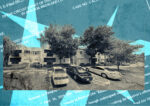Sterling Bay will tap a local design firm’s new modular construction process to build dozens of small-scale affordable apartment buildings on vacant lots across the city.
The development behemoth behind Lincoln Yards announced a deal Thursday to contract with Skender, which is set to start production this month at its 130,000-square-foot manufacturing facility in Little Village, to build 10 nearly identical three-flats on the West Side.
The firms also plan to build an 83-unit apartment building overlooking a Kennedy Expressway on-ramp at 1100 West Grand Avenue. Construction on the complex is scheduled to get underway early next year, with a projected completion by the end of 2020.
Modular construction, sometimes called “prefab” construction, involves building pieces of buildings at a centralized factory and then shipping them to construction sites, where they’re stacked like Legos. Skender says the process can nearly double the speed of construction on some buildings, and save builders up to 20 percent in costs over traditional methods.
The Chicago-based design firm is “at the tip of the spear” for the burgeoning construction practice, which could pave the way for large-scale construction that takes less than a year from groundbreaking to ribbon-cutting, Sterling Bay CEO Andy Gloor said.
We built McDonald’s [Fulton Market headquarters] in 18 months, and that was considered pretty fast,” Gloor said. “Most larger buildings take two years, so the ability to expedite your business plan is always a good thing.”
The first planned three-flat is expected to be completed in late August at 640 North Ridgeway Avenue in Humboldt Park, CEO Mark Skender said. His firm aims to eventually pump out each 3,750-square-foot building on a two-month production schedule, with each successive batch getting cheaper to produce.
“Like with any other product manufacturing company, our models will get better and better each year,” Skender said. “The first round of three-flats are our 2019 model, and in 2020 we’ll make improvements to our design and construction techniques.”
The firm is also working up an agreement with the city’s buildings department to “self-certify” successive building permits once each new model is approved, potentially cutting months of wait time.
The first round of buildings would comprise two-bedroom, one-bathroom apartments with rents capped at 60 percent of the city’s area median income. That means about $41,000 for a two-person household, or $51,000 for a family of four.
By the time the Skender facility reaches full capacity late next year, Sterling Bay expects to link up with non-profit property managers to erect affordable buildings on more than 100 vacant lots around the city, a spokesperson said. Some of the buildings may be used to help satisfy Sterling Bay’s obligation to build 300 off-site affordable units within a three-mile radius of Lincoln Yards.
Skender also announced an agreement with the Chicago Regional Council of Carpenters to allow the workers at its Little Village factory to unionize.
The Grand Avenue apartment building would replace an auto detailer on the site where broker-developer Sean Conlon secured zoning approval to build a seven-story apartment building in 2009. That project never materialized, but the decade-old city approval means Sterling Bay does not need to apply for a zoning change that would trigger the city’s Affordable Requirements Ordinance.
Still, Gloor said Sterling Bay would “absolutely” include affordable units in the makeup of the building.
Skender is in the “due-diligence” phase of deals to build 10 additional mid-rise multifamily buildings with different developers, including one in Uptown, Skender said.
A study last year found the city lost more than 20,000 apartments in small buildings between 2010 and 2016, as two- to four-unit buildings have been increasingly demolished or turned into single-family homes. Researchers have linked the phenomenon to a broader decline in affordable rentals across the city.
Sterling Bay has mostly laid low since last month, when it capped off a bruising nine-month public approval process by scoring zoning approval and tax increment financing for its 55-acre Lincoln Yards proposal. But the firm also recently unveiled plans to partner with DL3 Realty on at least a half-dozen South Side developments, and to create a biotech incubator and lab space called Prysm Life Sciences in Lincoln Park.




